One Word Responses to the Biennale de Lyon
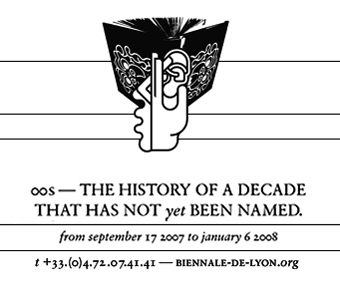
OUTSOURCING
François Piron
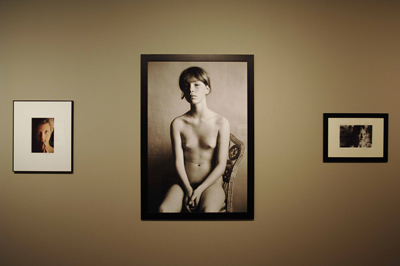
art-nègre
Sylvie Boulanger
David Hamilton invité par Eric Troncy
image: détail de l'installation, 34 photographies, avec le soutien du British Council, avec le soutien de Sikkens-Vachon, crédit photo Blaise Adilon

WATCHING-(YOU)
Judicaël Lavrador
Wade Guyton invité par Scott Rothkopf
Dis-connection
Cecilia Canziani
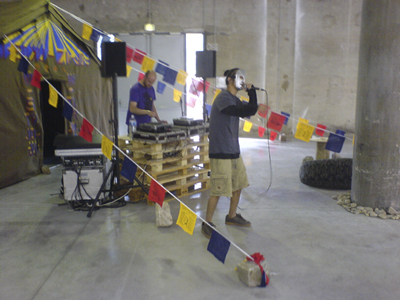
Moot(noun)
Matthew Shannon
Cao Fei invité par Hu Fang
image: Shannon
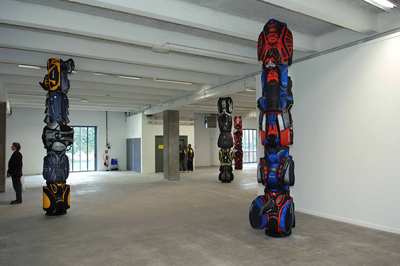
post-post-post-post[…]post-post-post-post-modern
Etienne Bernard
Brian Jungen invité par Trevor Smith
image: suc1 0084: vue d'installation, sacs de golf, tube en carton, collection privée Toronto. Courtesy Catriona Jeffries gallery, Vancouver,crédits photo Blaise Adilon.
No-play-on-display
Charlotte Laubard
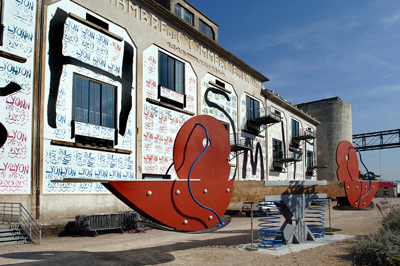
Sausages
Daniel Dewar
Liu Wei invité par Pi Li
image: « Seesaw », 2007, résine plastique et bois, métal, 500 x 150 x 1600 cm. Courtesy Liu Wei et Universal Studios, Beijing, crédits photo Blaise Adilon
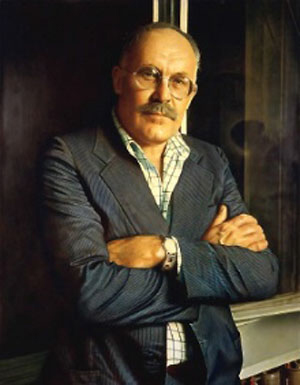
R.I.P.
Thomas Boutoux

Marie Muracciole

unannoying
Geoff Lowe
Nomeda et Gedimines Urbones invité par Natasa Petresin
image courtesy of the artists
Deception
Antoine Marchand
Tino Sehgal invité par Jens Hoffmann

ECOSYSTEME
Bénédicte Ramade
Tomas Saraceno invité par Daniel Birnbaum
Flying garden/airport city/60SW 2007, 60 ballons, cordes, 280 cm de diamètre,
courtesy de l'artiste et Tanya Bonakdar gallery, New York, Andersen-s contemporary, Copenhague, Pinksummer contemporary art, Gène, crédits photo Blaise Adilon
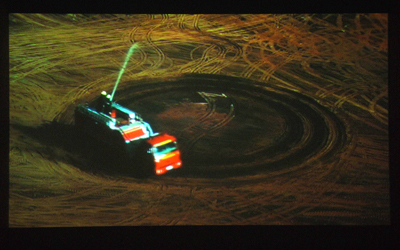
Glitch
Mathilde Villeneuve
Cinthia Marcelle invité par Jochen Volz
screen capture,Fonte 193 (Fountain 193), 2007, vidéo 5'40" en boucle, courtesy de l'artiste et Gallery Box 4,crédits photo Blaise Adilon

4 Comments:
A few bad leaps
A conservative press offers rewards to the reader for being duplicitous and even disingenuous. Don’t say what-you-think! Pretend to think something else for the sake of others and the long term. Like in the US when people savaged Ralph Nader for being so innocent as to say what he really thought, thereby taking strategic votes away from Al Gore. As a participant in our culture it becomes moral to be disingenuous and say-what-you-don’t-think.
In conservative Australia this has been going on for ten years with diabolical results, everyone habitually double-thinking to get what they want. Now nationalism appears as a new trend in French art. I feel at home.
From what I have heard many people in the French artworld felt pissed off that there were so few French artists invited into The Lyon Biennale 2007, THE 00s – THE HISTORY OF A DECADE THAT HAS NOT YET BEEN NAMED. This could be seen a result of the wanton dissolution of roles. It was a lost opportunity to present undervalued regional French contemporary art to the wider international audience. Apparently Saâdane Afif’s curated exhibition was an attempt to redress this issue. Yet probably more importantly as a friend wrote to me:
“the feeling of nationalism comes to me when I’m ashamed and when I have the feeling that the world is going to laugh at us. I don't care really, but I don't like when French art appears ridiculous. It won’t be because of nationalist exhibitions, and self-celebratory attitudes (ignorant of what's going on elsewhere), that this is recognition is going to happen.”
In Australia there are 13 million pornographic dvds sold each year, yet it has recently been made a capital offence for indigenous Australians to have more than 2 in their possession. At the same time Murdoch’s cable porn channel is easily available and targets these people in remote communities as consumers. The figure/ground relation of our citizenry is constantly changing.
This changing background provides us with opportunities to think about how we are strategically disingenuous in terms of a biennale or this Lyon Biennale that frames itself in terms of participation and collaboration. It has been written that there was ‘no together’, there were ‘no cartels’, ‘no collaboration’ or on this site ‘no-play-on-display’. Few consumers seemed to receive what they were meant-to-be-getting. I found it unannoying.. www.liberation.fr/ said:
“…Cartel. La proclamation du «tous ensemble» débouche à l’arrivée sur une exaltation du chacun pour soi, dont on sait que, tel un gaz asphyxiant, il est dans l’air politique du moment. Autrement dit, un nivellement par le milieu, qui par définition tire vers le bas et expose au risque du médiocre. Et de la confusion, aggravée par un laxisme des cartels. Dans une manifestation publique, on est en droit d’espérer plus de clarté, de lisibilité, de pédagogie.”
As a viewer there is often an impulse to be very critical about a biennale. The biennale must be at once definitive and widely inclusive. The title of such a show often changes over its inception where the curators offer a colon and a qualifying statement as if to admit the subject they chose isn’t really possible to arrive at. It’s also tricky because this biennale (against its best intentions) makes a space for history in the present, which violates the fact that that history will be built from a later perspective. It’s History Now rather than History No!
To be very critical is a sign, I guess, that you have interrogated or even deconstructed the title and terms and often the politics of the show that was offered to you. Then it’s a rush to see who can be critical in the right way. This process shows the event has been consumed, often by being ravaged by the audience and viewers. I found it an unannoying exhibition because the curators trusted the second circle of curators who invited the artists. There was, in a sense, no curatorial position and it was left up to the audience to decide and deal with the fragmentary events that were offered. No one, including the curators, knew what this show meant and it is for the audience, the users, to decide and proceed. The question, who is the ‘essential’ artist of the decade? can only be left as bizarre, however the fragmentation and uncertainty of the subject, for me, became enabling. As Nietzsche might have said“Even a cowardice, a laziness” from the curators offers an opportunity to be definitive as the next layer of audience. As a defense against cries of phony democracies, collaborations and interfaces it seems The Palais de Tokyo has made a distinct step towards becoming a genuine Kunstalle. Is it perhaps unbearable to keep the question open? We welcome further comments…
THE 00s – THE HISTORY OF A DECADE
THAT HAS NOT YET BEEN NAMED
Stéphanie Moisdon and Hans-Ulrich Obrist
Notes from a continuous conversation between Stéphanie Moisdon
and Hans-Ulrich Obrist
THE 00s
The next Lyon Biennial will open on 17 September 2007 as part of an ongoing attempt – more than ten years now – to home in on the vital questions regarding creativity in its most up-to-date forms. The objective of this Biennial is a history book written by several hands. The history of a decade not yet named.
THE BIENNIAL
Our era has done with the movements and the ideological, national, stylistic and generational rallyings that structured the preceding decades. The profusion of artistic currents, the extraordinary diversity they represent in terms of styles, media and ambitions, and the coexistence on the same stage of artists from so many different backgrounds and speaking so many different languages: all this makes any attempt to sum up the current scene more complex. At the same time the biennial phenomenon has continued to grow and shift, generating a debate about formats, procedures and local and international implications: a debate that goes hand in hand with a dislocation of reality and its representation and forces us to rethink our relationship with the forms taken by art and exhibitions, to experiment with new methods and to produce new alliances.
THE GAME
How to write a history of this period, of the clash of opposites? How to reinvent a way of speaking, creating, laying oneself bare and thinking one’s way through the non-linear space in which art emerges? This biennial’s method uses the structure of an enormous game, with rules for choosing and allotting roles. And the game is binding: it can only be played once. It takes the form of an investigation involving 60 players: curators from all over the world, bringing their personal experience to bear on producing the living materials of an archaeology of the present.
THE RULES
The players form two circles. The first is a community of critics and curators who are asked a single question: “In your opinion which artist or which work has a vital place in this decade?” This question functions as a rule. The second circle is a group of artists, each entrusted with the creation of an entire sequence which, according to the individual method, defines the decade. The montage of these different sequences results in a vision like that of the chapters of a history book.
THE CHOICE
The structure of this progress does not lie in delegating choice; rather it allows for a shift in the criteria of appearance, authorship, collaboration and the hierarchy of knowledge, for a reconsideration of the notion of the list that has become one of the forces shaping the relationship to art in the mechanism of biennials and reflects that universal passion for thinking in categories. The accumulation of all these propositions – divergent and coincident – gradually gives rise to a single landscape, the portrait of an immediate present and its passengers.
THE COLLECTIVE APPROACH
In structural terms the game is as much a space for reflection on the notion of the collective at the turning of this new century as a way of producing arborescences – a proliferation of potential histories. Each part of the exhibition retains the imprint of the initial, arbitrary rule; and thus relieved of the burden of thematisation, of the habitual conventions of allotting roles and territories, the exhibition becomes the factual image of all the combinations, choices, constraints, fortuities and necessities that integrate the programme of the period, with all its lasting or ephemeral passions.
Nor is it a matter of creating another fame barometer, and even less of setting up a ranking according to the aesthetic, economic or symbolic value of the works. Thus the formulation of the question – and the use of the word “vital” – is intended to include the two strands that determine the players’ judgement, which simultaneously reflects historical objectivity and the subjectivity of each of them.
Geoff, I definitely agree with you that perhaps part of the consistency of dissatisfaction surrounding the reception of the biennale could be a result of the slight peculiarity in attempting to write a history of the present. The curator does also hold a unique power in their selection of works to draw new associations between artists and content, a piece's placement within a show may significantly affect its meaning, leaving much room for an audience to disagree with the subsequent manipulation of a work's perception.
Indeed it is very much a right of the curator to apply their personal interpretations of an artwork to a show, however this tampering of the artist's intent may not sit well with audiences, and could perhaps be a key cause for dissatisfaction.
just a minor quibble - I agree with Kate. I was missing the new posts because the one word responses are being kept at the top of the SPEECH page. It gives the impression that nothing new is being added.
Post a Comment
Note: Only a member of this blog may post a comment.
Subscribe to Post Comments [Atom]
<< Home